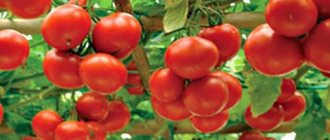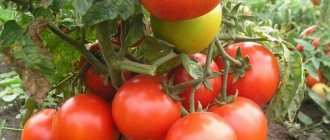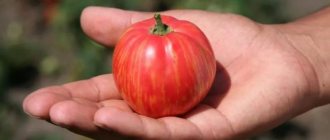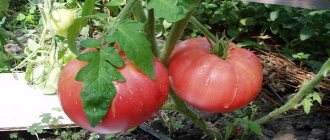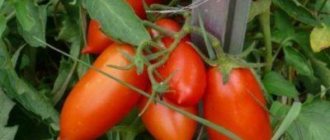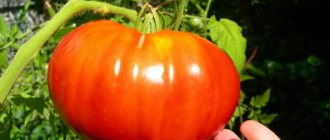Description and characteristics of the variety
| Height | Landing location | Ripening time | Fruit color | Fruit size | Origin | Fruit shape |
| short | Open ground | Ultra early | Reds | Average | Hybrid | Flat-round |
They produce salad-type fruits, flat-round, smooth, dense, resistant to cracking. The color of unripe tomatoes is green, while ripe tomatoes are bright red. The fruits have 4 or more nests. The taste is excellent. The fruits are suitable for fresh eating, pickling, and preparing tomato products: sauces, juice, purees, pastes.
The type of growth is determinant. The main stem stops lengthening after 4-5 clusters are laid. The first brush is formed after 5-7 sheets, then brushes appear every two sheets. It is better to tie up the bushes so that they do not fall to the ground.
The hybrid is excellent for growing without seedlings in open ground. It makes sense to cultivate it in greenhouses only in the northern regions. Can be grown for sale - the fruits are well transported and have an excellent presentation. Fruits collected unripe are stored indoors for up to 30 days.
How to care for tomato beds
The area for tomatoes is prepared in advance: in the fall the ground is dug up and fertilized. In the spring, just before planting, the soil is loosened and weeds are removed. The Anyuta tomato does not require special soil composition; timely application of fertilizing is sufficient.
It is better to transplant tomatoes into the garden in cloudy weather or in the evening. You need to remove seedlings from containers immediately before planting, after moistening the soil in cups.
Important! On the eve of planting (several days before), nitrogen fertilizers are applied to the ground at the rate of 20-33 g per square meter.
Watering rules
After planting, the first watering is done after 2-3 days. You should try to pour water under the roots of the tomatoes, avoiding liquid getting on the leaves.
Important! You cannot water Anyuta F1 tomatoes by sprinkling, as this technique leads to a decrease in air and soil temperatures. This can cause flowers to fall off and tomatoes to become infected with fungal diseases.
In sunny, dry weather, it is recommended to water in the evening so that the water does not evaporate quickly and soaks the soil well. Before the first ovary appears, you should not water frequently - it is enough to maintain soil moisture at the same level. As soon as the fruits of Anyuta tomatoes begin to gain weight, it is necessary to increase the volume of watering. But at the same time, the soil must be moistened regularly; sharp contrasts should not be allowed. A strong change in soil moisture can lead to cracking of tomatoes and slower growth of the ovary.
After moistening, the soil must be loosened. At the same time, weeds are carefully removed and attention is paid to the roots of the Anyuta tomato variety. If adventitious roots are exposed, the bushes should be spudded.
Fertilizer application
Three weeks after transplanting the Anyuta tomato seedlings into open ground, the first fertilizing is carried out. It is recommended to use liquid fertilizer “Ideal” and nitrophoska (a tablespoon of each component is diluted in 10 liters). 500 g of solution is added to each bush.
When the flower clusters begin to bloom, apply the next portion of fertilizer. To make a nutrient solution, dilute a tablespoon of Signor Tomato fertilizer in 10 liters of water. For one tomato bush of the Anyuta variety, a liter of mixture is enough. After two to three weeks, you can apply a superphosphate solution (a tablespoon per 10 liters of water).
Those who like organic fertilizers can use bird droppings. To create a solution, take equal amounts of litter and water. The mixture is infused for 3-4 days. To avoid burning the roots of the tomato, the resulting concentrate is additionally diluted with water in a ratio of 1:15. Approximately 2-2.5 liters of fertilizer are poured under each bush.
If there are weak bushes, it is recommended to carry out foliar feeding - Anyuta tomatoes are sprayed with a urea solution (a tablespoon of fertilizer per 5 liters of water).
Tomatoes of the Anyuta variety are very popular among summer residents and gardeners due to their early ripening and resistance to diseases. This tomato is perfect for growing both in small dachas and in established farms.
History of selection and region of growth
Tomato Anyuta and “Partner” are a modern hybrid of the first generation. Entered into the state register in 2005. Recommended for garden plots in the North Caucasus region, which includes:
- republics - Crimea, Adygea, Dagestan, Chechen, Ingush, Kabardino-Balkaria, North Ossetia-Alania;
- Krasnodar and Stavropol territories;
- Rostov region.
When breeding the variety, the effect of heterosis was used - an explosive increase in the productivity of the first generation. The yield of such hybrids is 20-30% higher than the parent.
Seeds of heterotic hybrids cannot be independently collected from fruits for sowing the next year - the plants that emerge from them do not retain typical parental characteristics.
Characteristics of the tomato Anyuta
The Anyuta tomato has an ultra-short ripening period. The first fruits will ripen 85-95 days after planting the seeds for seedlings. High early maturity allows some farmers to harvest a double harvest. When planting seeds in March, the bushes begin to bear fruit by the end of June. The next batch of seeds is planted for seedlings in May, and the harvest is harvested in the second half of August.
Anyuta tomato productivity and fruiting
The Anyuta tomato has an average yield: approximately 2.4-2.6 kg is harvested from one bush. No more than 7 plants are planted per 1 m². Since Anyuta is a hybrid variety, collecting seeds for planting next year is not practiced.
Area of application of fruits
Anyuta tomatoes are used mainly for making salads. However, many gardeners claim that ripe fruits make very tasty juices and sauces. Tomatoes are great for pickling.
The Anyuta tomato has a sour taste, so it is recommended to add sugar when making pastes or sauces.
Resistance to diseases and pests
The Anyuta tomato is characterized by increased resistance to certain types of diseases and pests. The variety is immune to the tobacco mosaic virus, which causes deformation of leaf plates and the appearance of whitish spots. Blossom end rot, which looks like small dry spots that gradually darken and spread over the surface of the fruit, does not pose a danger to the Anyuta tomato. The hybrid variety is resistant to late blight, as well as Fusarium and Alternaria wilt.
Features of cultivation
A distinctive feature of the hybrid is its undemanding nature regarding soil composition. However, 1-2 complex fertilizing with mineral fertilizers will be beneficial and increase the yield. Instead of fats, you can add a mixture of wood ash and humus to the ground. Organic matter is added once - before planting seedlings in holes or for digging before sowing seeds in open ground.
Due to the early ripening and friendly yield of fruits in the southern regions, Anyuta can be sown in two terms. If you sow the seeds in March, active fruiting will begin at the end of June. The second batch of seeds is sown in early May and harvested in mid-August.
How to sow and grow
Sow Anyuta seeds in late March - early April. In the south, you can sow directly into the ground, under temporary shelter, or grow seedlings in greenhouses and greenhouses. Although the hybrid is resistant to disease, when seedlings are kept on a windowsill, tender seedlings can die from blackleg. Therefore, for prevention, warm the soil to 100 °C or pour boiling water in advance, and wash the seeds in a solution of potassium permanganate.
I don’t fry the soil on the stove or in the oven, but treat it with boiling water. To do this, I collect the volume of soil I need, pour it into a bowl and slowly scald it, stirring and breaking up the lumps. When the whole mass turns into a homogeneous thick slurry, I place it on the windowsill. Once or twice a day I go up and mix it so that the earth does not turn into a lump. Usually after 3-4 days the soil becomes suitable for sowing - loose and of normal humidity.
Favorable temperature for tomato germination is +25 °C. Water the seedlings without letting the soil dry out. After the first true leaf appears, separate them into different pots. From the moment of her appearance, Anyuta demonstrates the diminutiveness of the bush, so large glasses are not needed, a volume of 200 ml is enough.
Disposable plastic cups are the most suitable container for growing Anyuta
Tomato seedlings should be watered with settled water as soon as the soil dries to a depth of 1 cm. 2–3 weeks after picking, if the lower true (not cotyledon) leaves turn yellow, feed with nitrogen fertilizer - a solution of urea, ammonium nitrate or a complex mixture for seedlings (Fertika , Agricola, Blank Sheet, etc.). Follow the dosage strictly; it is better to take less fertilizer than to overdo it.
The lower leaves turn yellow, which means there is not enough nitrogen
On the windowsill, Anyuta's seedlings should form 5-6 true leaves and form the first buds. A week before planting in the garden, begin hardening, gradually accustoming the seedlings to sunlight, wind and temperature changes. Plant when danger of frost has passed.
Anyuta’s placement scheme is 70x30 cm or 50x40 cm. Before planting, add 6–8 kg of humus or compost and 0.5 kg of wood ash per 1 m² to the ground. If there are no natural fertilizers, buy a ready-made mixture like Gumi-Omi for tomatoes in the store or apply simple mineral fertilizers: a tablespoon of superphosphate, potassium sulfate and urea per 1 m². You don’t have to distribute it over the entire bed, but pour a level teaspoon of each into the bottom of the hole.
Video: planting low-growing tomatoes in the ground
After planting, water the tomatoes 1-2 times a week, spending 3-5 liters per bush. Once every 2-3 weeks, feed with special fertilizers for tomatoes, for example, Red Giant mixture. In stores you can find fertilizers with other names, the main thing is that the percentage of potassium in the composition is higher than nitrogen.
Be sure to tie up the bushes, otherwise they will be tossed around by the wind and pinned to the ground by the rain. For low-growing tomatoes, it is more rational not to install pegs near each one, but to make a garter like a trellis:
- Drive in columns at the beginning and end of the row, and if the rows are long, add 1-2 more intermediate columns.
- At a height of a meter from the ground, stretch wire or nylon twine from post to post.
- Tie strings above each tomato to the resulting trellis and use them to secure the tomatoes in a vertical position (as in a greenhouse).
Low-growing tomatoes are tied to a rope stretched over them
Decide for yourself whether or not to plant the Anyuta tomato, depending on the expected result. If you need a lot of medium-sized tomatoes for pickling, then don’t pick them. And if you want to quickly get fruits for salads, then break off all the stepsons below the first cluster, and leave 3-5 flowering shoots on top. There will be fewer ovaries, and most importantly, tops, the fruits will receive more light and nutrition, so they will grow larger and ripen earlier.
Anyuta tomatoes will ripen together, if you have a lot of bushes, then get ready to collect and process a rich harvest. Large fruits are suitable for making juice, lecho, paste, ketchup, while small ones are pickled or pickled whole.
Gardeners about the variety
Lyudmila, Tver
See also
Description of the tomato variety Dinar, recommendations for growing and yieldRead
I have been growing the Anyuta hybrid for several years now. Attracts early and friendly ripening. All fruits turn out smooth, even, and fall within the description of the variety given on the envelope with the seeds.
Svetlana, Belgorod
This is not the first year I have planted Anyuta F1. I was attracted by the main characteristic of the tomato – early ripening. I love to please my family with tomato dishes, Anyuta is perfect for this. They completely met my hopes for the harvest. I plant seeds for seedlings at the end of February, and in June we already eat salads. For this alone you can love this variety.
Tomato: advantages and disadvantages
The Anyuta F1 hybrid has proven itself well when grown in open ground in the southern regions.
Its "advantages":
- Fast ripening time.
- The compactness of the bushes allows you to grow tomatoes in dense plantings.
- Productivity.
- Disease resistance.
- Suitability for transportation.
- Versatility. Tomato Anyuta F1 is used for salads, preparing various sauces, juices, and seasonings. Some summer residents also use Anyuta for canning, but here everything is not for everyone.
Special mention should be made about the disease resistance of this hybrid. The Anyuta tomato is not susceptible to blossom end rot, does not suffer from the tobacco mosaic virus - the worst enemy of many varieties and hybrids of tomatoes, and is relatively resistant to late blight.
Most of the crop has time to ripen before late blight appears, and this is very important.
There is only one disadvantage: the limited areas of zoning of the hybrid. According to the register, Anyuta F1 is zoned in the North Caucasus region, where it has proven itself as an open-ground tomato.
But in other regions and regions, although there is evidence of its successful cultivation, it is still preferable to choose other varieties and hybrids of tomatoes.
However, it is always up to the gardeners themselves to decide, and we can only tell and recommend.
Reviews from those who planted and grew Anyuta indicate that this hybrid is characterized by stable yields, bearing fruit every year without visible declines.
It is clear that if you want to grow a hybrid in northern regions with more severe climatic conditions, you will need to plant it in a greenhouse or, in the case of open ground, the mandatory use of film shelters.
There are no special agrotechnical techniques when growing a hybrid, everything is as usual. The main thing is proper care and care, and the harvest does not have to wait long!
Natalia Severova
Hybrid "Anyuta" is characterized by the following advantages:
- Compactness;
- Early ripening;
- Possibility of cultivation in unprotected soil;
- High taste characteristics;
- Good preservation during transportation;
- Resistant to tomato diseases;
- Good presentation of the fruit;
- Possibility of obtaining two harvests per season.
Gardeners who grow tomatoes only regret that they cannot collect seeds from the fruit and have to buy them every time. But this is perhaps the only drawback of the hybrid, but there are many advantages, which include:
- Unpretentious to care and soil.
- Fast ripening of fruits.
- The presence of immunity to disease.
- Long shelf life of tomatoes.
Tomatoes for open ground: video
This variety is suitable for growing outdoors only in regions with warm climates. A shaded area will not suit this crop; it needs a lot of light: lack of lighting will affect fruiting.
To obtain the maximum amount of fruit, farmers use an agricultural technique - growing on double roots. It begins at the picking stage. Two sprouts are planted in one container with a distance of no more than 1 cm. After the seedlings take root, small cuts are made on the sides with which they are directed towards each other, they are connected and tied with film. When transplanting seedlings into the ground, the weaker top is removed.
Application of fruits
This early ripening variety bears fruit twice per season. The first vegetables are harvested from the end of June. The second harvest occurs in mid-August and, in warm weather, continues for another month.
Farmers saw material benefits in double harvesting, and the variety began to be successfully used for commercial purposes. In addition, vegetables have a long shelf life, which allows them to be transported over long distances. The shelf life of fresh vegetables is up to 30 days.
In cooking, tomatoes look good in salads, ideally complementing other vegetables. The autumn harvest is suitable for canning, pickling, and twisting. They also prepare other tomato products: ketchups, juices, pastes - in winter, such a solution looks good on any table.
And yet, the main merit of the culture remains the long-term storage of fresh vegetables without loss of gastronomic properties.
Tomatoes are great for various canning, preparing salads, producing tomato paste and tomato juice.
The fruits of the “Anyuta” f1 tomato are stored for a long time without losing their gastronomic qualities. They are well transported to the place of sale. They supply tomatoes to retail outlets, restaurants and catering facilities. Eat fresh and make salads. In homemade preparations they are used for making juice, pickling, and canning.
Hybrid tomato "Anyuta f1" has good immunity against common nightshade infections. The variety is not affected by: macrosporiosis, a type of fruit and root rot, mosaic, fruit cracking. Possible late blight. Among the insects that parasitize the crop are nematodes, larvae of the Colorado potato beetle and whitefly moth, and less commonly, spider mites.
Hybrid tomato species rarely have serious deficiencies. During experimental cultivation, breeders eliminate the shortcomings of the variety. The conditional disadvantages of the “Anyuta” f1 tomato include average resistance to pests and the need for sufficient lighting. Excess or deficiency of moisture is not relevant for tomatoes.
According to vegetable growers, Anyuta f1 tomatoes (pictured) are characterized by a number of advantages:
- grown in open ground and protected structures;
- good taste and aesthetic presentation;
- the variety reaches biological ripeness at the beginning of summer;
- Two crops are harvested per season;
- tomato is undemanding to watering;
- resists diseases well;
- The fruits are of a convenient size, suitable for preservation.
A universal tomato.
Pest and disease control
The tomato hybrid "Anyuta" has good resistance to common tomato diseases. The hybrid does not affect macrosporiosis, types of fruit and root rot, tobacco mosaic, and fruit cracking. Possible late blight. Of the pests, tomato most often suffers from nematodes, Colorado potato beetle larvae and whitefly moths, and sometimes from spider mites.
It is not recommended to place the “Anyuta” f1 tomato near nightshade crops. The planting site must be changed every 3 years. If late blight develops on tomatoes, it is necessary to remove the affected parts from the plant, treat the variety with Bordeaux mixture, Barrier, and Fitosporin preparations. The products will destroy fungal spores, the cause of infection.
To prevent diseases, tomatoes are treated with copper sulfate.
To destroy insects parasitizing on tomatoes, use:
- “Fitoverm” for whiteflies, irrigate the lower part of the leaf, the place where caterpillars accumulate;
- “Anti-mite”, “Carbophosphorus” for spider mites;
- “Iskra”, “Prestige” will destroy the Colorado potato beetle.
The remaining larvae are collected by hand.

